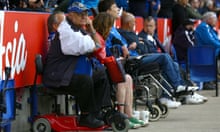We all need to go. And however we need to do this, we should have privacy as well as access to fulfil this most basic biological need freely and with dignity.
I ached with sympathy on hearing about Anne Wafula Strike’s experience. The award-winning Paralympic athlete and disabilities campaigner says she was “robbed of her dignity” after a train company failed to provide an accessible toilet on a three-hour journey. And I felt an old, weary anger. You might believe the Paralympian’s distressing experience is an unusual occurrence, but sadly it isn’t. The reality for many disabled people is it’s a muddle and a minefield to have an easy pee.
While situations such as Wafula Strike’s are unacceptable and degrading, sometimes they can be horribly funny.
A few years ago I went to New York with Virgin. The cabin crew were charming, but I ended up about as far away from the appropriate toilet as I could be. And what with the faffing about that occurs before and after you board as a disabled person, this meant at least a seven-hour wait. Luckily my personal assistant, Janet, was undaunted. We made it to the general toilet, only to discover that the cubicle was so small it looked unlikely we would fit in it together and so we did what has now gone down in our personal history as the belly dance. We manoeuvred: left a bit, right a bit, belly shift sideways. Somehow she got me on that tiny bog. And goodness, did I enjoy my comedy-length wee.
I’ve had run-ins with Virgin train lavatories too. Take many journeys west, and there’s a doomed inevitability that the multipurpose toilet will break down. The wheelchair space is very close to the toilet. That’s good – but not when it fails, and is emitting the stench of a medieval cesspit. Even when the train toilets work, many are just too small if you need a PA or carer, and to take your wheelchair into the cubicle. This has been true for me on every Eurostar trip I’ve made. Maybe I’ll need to get creative and wear triple Pampers when I am next en route to Marseille.
Like Wafula Strike, in her unpleasant situation, I’ve wet myself (or worse) due to any number of avoidable toilet obstacles. Many disabled people are familiar with parents wanting to use the often dual-purpose accessible toilet to change a child’s nappy. In my case, a young woman “nipping in” with a grizzling toddler once meant that I found myself forlorn and embarrassed, sitting in soggy knickers and left with a rank chair cushion.
Another irritant is when the accessible loo is used as a storage room. Pubs and clubs are particularly guilty of this habit, and roll out a tired argument when challenged: we don’t get many disabled people in here. Really, I ask. I wonder why. Sometimes there are obstacles plonked in front of the door: anything from high chairs, bikes and toilet rolls to – I remember once – three woebegone dogs. And no one responsible for moving any of them.
There’s controversy about who is disabled “enough” to use an accessible toilet. As a wheelchair user, I try to withhold judgment, not least because not all people in need of an accessible loo will look disabled. I have friends with IBS, stoma bags and long-term medical conditions who all need the space as much as I do. The supermarket Asda has made good efforts to address this situation. But for every genuine case there is always the young guy dashing out of my local M&S loo in smart new trainers – box left inside.
The Radar key scheme, to get into more than 9,000 accessible toilets, was set up in 1981 by the organisation that morphed into Disability Rights UK. You can still buy the keys from them, and even on eBay. This may explain another unpalatable experience for the disabled visitor in need: the leftover paraphernalia of drug use. Last year in a Radar accessible toilet I discovered a dirty syringe in the bowl.
There has been an effort to improve access to toilets for people needing a hoist and a bench with the Changing Places campaign. I’ve used a few of these, and while I don’t need a hoist I do appreciate the provision of a space where I can fit – with my PA. Still, these are relatively few in number compared with standard accessible toilets.
There is, of course, another use for the accessible toilet: it’s a good space for a shag. And I can hardly complain about that, as I’m as guilty as anyone.
But there is a serious point here. Even this week, in a store at the sales, I found myself facing yet another out-of-order sign on the accessible toilet, as I watched everyone else doing what they needed to without a thought. I’m still angry every time this happens – we have to be. And I wish – as non-disabled people wish – to have a toilet available wherever I am when nature calls.







